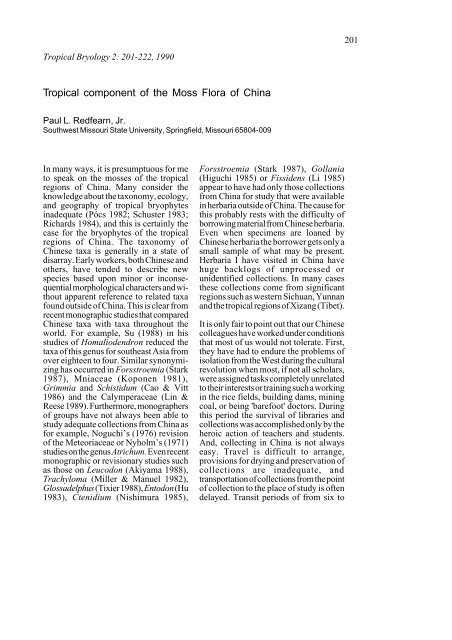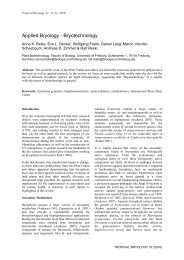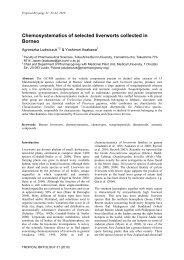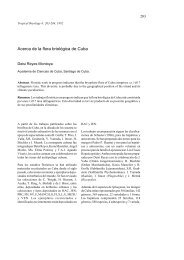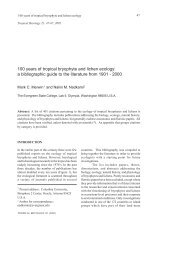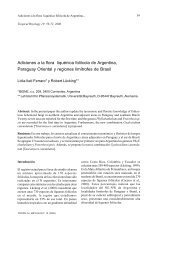Tropical component of the Moss Flora of China
Tropical component of the Moss Flora of China
Tropical component of the Moss Flora of China
You also want an ePaper? Increase the reach of your titles
YUMPU automatically turns print PDFs into web optimized ePapers that Google loves.
<strong>Tropical</strong> Bryology 2: 201-222, 1990<br />
<strong>Tropical</strong> <strong>component</strong> <strong>of</strong> <strong>the</strong> <strong>Moss</strong> <strong>Flora</strong> <strong>of</strong> <strong>China</strong><br />
Paul L. Redfearn, Jr.<br />
Southwest Missouri State University, Springfield, Missouri 65804-009<br />
In many ways, it is presumptuous for me<br />
to speak on <strong>the</strong> mosses <strong>of</strong> <strong>the</strong> tropical<br />
regions <strong>of</strong> <strong>China</strong>. Many consider <strong>the</strong><br />
knowledge about <strong>the</strong> taxonomy, ecology,<br />
and geography <strong>of</strong> tropical bryophytes<br />
inadequate (Pócs 1982; Schuster 1983;<br />
Richards 1984), and this is certainly <strong>the</strong><br />
case for <strong>the</strong> bryophytes <strong>of</strong> <strong>the</strong> tropical<br />
regions <strong>of</strong> <strong>China</strong>. The taxonomy <strong>of</strong><br />
Chinese taxa is generally in a state <strong>of</strong><br />
disarray. Early workers, both Chinese and<br />
o<strong>the</strong>rs, have tended to describe new<br />
species based upon minor or inconsequential<br />
morphological characters and without<br />
apparent reference to related taxa<br />
found outside <strong>of</strong> <strong>China</strong>. This is clear from<br />
recent monographic studies that compared<br />
Chinese taxa with taxa throughout <strong>the</strong><br />
world. For example, Su (1988) in his<br />
studies <strong>of</strong> Homaliodendron reduced <strong>the</strong><br />
taxa <strong>of</strong> this genus for sou<strong>the</strong>ast Asia from<br />
over eighteen to four. Similar synonymizing<br />
has occurred in Forsstroemia (Stark<br />
1987), Mniaceae (Koponen 1981),<br />
Grimmia and Schistidum (Cao & Vitt<br />
1986) and <strong>the</strong> Calymperaceae (Lin &<br />
Reese 1989). Fur<strong>the</strong>rmore, monographers<br />
<strong>of</strong> groups have not always been able to<br />
study adequate collections from <strong>China</strong> as<br />
for example, Noguchi’s (1976) revision<br />
<strong>of</strong> <strong>the</strong> Meteoriaceae or Nyholm’s (1971)<br />
studies on <strong>the</strong> genus Atrichum. Even recent<br />
monographic or revisionary studies such<br />
as those on Leucodon (Akiyama 1988),<br />
Trachyloma (Miller & Manuel 1982),<br />
Glossadelphus (Tixier 1988), Entodon (Hu<br />
1983), Ctenidium (Nishimura 1985),<br />
Forsstroemia (Stark 1987), Gollania<br />
(Higuchi 1985) or Fissidens (Li 1985)<br />
appear to have had only those collections<br />
from <strong>China</strong> for study that were available<br />
in herbaria outside <strong>of</strong> <strong>China</strong>. The cause for<br />
this probably rests with <strong>the</strong> difficulty <strong>of</strong><br />
borrowing material from Chinese herbaria.<br />
Even when specimens are loaned by<br />
Chinese herbaria <strong>the</strong> borrower gets only a<br />
small sample <strong>of</strong> what may be present.<br />
Herbaria I have visited in <strong>China</strong> have<br />
huge backlogs <strong>of</strong> unprocessed or<br />
unidentified collections. In many cases<br />
<strong>the</strong>se collections come from significant<br />
regions such as western Sichuan, Yunnan<br />
and <strong>the</strong> tropical regions <strong>of</strong> Xizang (Tibet).<br />
It is only fair to point out that our Chinese<br />
colleagues have worked under conditions<br />
that most <strong>of</strong> us would not tolerate. First,<br />
<strong>the</strong>y have had to endure <strong>the</strong> problems <strong>of</strong><br />
isolation from <strong>the</strong> West during <strong>the</strong> cultural<br />
revolution when most, if not all scholars,<br />
were assigned tasks completely unrelated<br />
to <strong>the</strong>ir interests or training such a working<br />
in <strong>the</strong> rice fields, building dams, mining<br />
coal, or being 'barefoot' doctors. During<br />
this period <strong>the</strong> survival <strong>of</strong> libraries and<br />
collections was accomplished only by <strong>the</strong><br />
heroic action <strong>of</strong> teachers and students.<br />
And, collecting in <strong>China</strong> is not always<br />
easy. Travel is difficult to arrange,<br />
provisions for drying and preservation <strong>of</strong><br />
collections are inadequate, and<br />
transportation <strong>of</strong> collections from <strong>the</strong> point<br />
<strong>of</strong> collection to <strong>the</strong> place <strong>of</strong> study is <strong>of</strong>ten<br />
delayed. Transit periods <strong>of</strong> from six to<br />
201
twelve months are not uncommon.<br />
Finally, <strong>China</strong> is a large and diverse<br />
country and <strong>the</strong> number <strong>of</strong> bryology<br />
students are few by European and North<br />
American standards. There are many areas<br />
that need intensive study and this most<br />
certainly includes <strong>the</strong> tropical region <strong>of</strong><br />
<strong>China</strong>. Those <strong>of</strong> us from <strong>the</strong> West that<br />
have been able to collect in limited areas in<br />
<strong>China</strong> are finding new species (Reese &<br />
Lin 1989) or taxa new to <strong>China</strong> (Redfearn<br />
et al 1989; Vitt personal communication).<br />
Although Chinese bryologists are busy<br />
today working on <strong>the</strong> bryophyte flora <strong>of</strong><br />
<strong>China</strong>, such studies are not high on <strong>the</strong> list<br />
<strong>of</strong> government priorities. Even so, floras<br />
for specific provinces or regions have<br />
been prepared, such as <strong>the</strong> <strong>Flora</strong> <strong>of</strong> Xizang,<br />
and <strong>the</strong> floras <strong>of</strong> Yunnan, Hainan, and<br />
Sichuan provinces are currently in<br />
preparation. Unfortunately, <strong>the</strong>se floras<br />
have been or are being prepared without a<br />
solid base <strong>of</strong> taxonomic studies <strong>of</strong> <strong>the</strong><br />
Chinese taxa.<br />
Ecological studies <strong>of</strong> tropical bryophytes<br />
in <strong>China</strong> are essentially lacking. This is<br />
due, in part, to a lack <strong>of</strong> training, equipment,<br />
and time. Many <strong>of</strong> <strong>the</strong> present bryologists<br />
in <strong>China</strong> received <strong>the</strong>ir education during<br />
<strong>the</strong> cultural revolution when <strong>the</strong> study <strong>of</strong><br />
ma<strong>the</strong>matics was considered unnecessary<br />
and when <strong>the</strong>y were isolated from <strong>the</strong><br />
exciting developments occurring in<br />
ecology elsewhere.<br />
With <strong>the</strong>se problems in mind, I will review<br />
for you what is known, and which is<br />
surely only a fraction <strong>of</strong> what is to be<br />
learned, about <strong>the</strong> mosses <strong>of</strong> tropical <strong>China</strong><br />
and to suggest how our knowledge might<br />
be significantly increased in <strong>the</strong> next<br />
decade.<br />
<strong>Tropical</strong> plant communties in <strong>China</strong><br />
There are three types tropical plant communities<br />
in <strong>China</strong> (Hou 1983) found in<br />
<strong>China</strong> (Fig. 1). One type is <strong>the</strong> Bamboo<br />
evergreen forests <strong>of</strong> subtropical and<br />
tropical zones. This plant community is<br />
extensively developed in Sichuan and<br />
sou<strong>the</strong>rn <strong>China</strong>. Little is known about <strong>the</strong><br />
bryophytes <strong>of</strong> <strong>the</strong>se bamboo forests and I<br />
will not attempt to discuss this type <strong>of</strong><br />
community.<br />
A second type <strong>of</strong> tropical plant community<br />
is <strong>the</strong> <strong>Tropical</strong> broad- leaved semievergreen<br />
forests. This community is<br />
extensively developed in southwestern<br />
Guangxi, Xishuangbanna in Yunnan and<br />
Guangdong. These forests have a dry<br />
season and as <strong>the</strong> dry season becomes less<br />
distinct <strong>the</strong>y become more and more similar<br />
to <strong>the</strong> <strong>Tropical</strong> Rain Forests discussed<br />
below. These semi-evergreen seasonal<br />
forests differ from tropical rain forests in<br />
several characteristics (Hou 1983). Trees<br />
<strong>of</strong> <strong>the</strong> upper layers are lower and very few<br />
<strong>of</strong> <strong>the</strong> larger trees are buttressed. Lianas<br />
and epiphytes are less abundant. In<br />
Xishuangbanna and Guangxi <strong>the</strong>se forests<br />
are found on calcareous soils. However,<br />
on western Hainan Island, this type <strong>of</strong><br />
forest occurs on acid soils.<br />
The third type <strong>of</strong> tropical vegetation is <strong>the</strong><br />
<strong>Tropical</strong> broad- leaved evergreen rain<br />
forest. Located on <strong>the</strong> eastern sides <strong>of</strong><br />
Hainan and Tawain islands, in<br />
sou<strong>the</strong>astern Yunnan Province, and in <strong>the</strong><br />
extreme part <strong>of</strong> southwestern Tibet, <strong>the</strong>se<br />
forests are characterized by a climate that<br />
is moisture saturated throughout <strong>the</strong> year.<br />
Evergreen trees in <strong>the</strong> families Moraceae,<br />
Myrtaceae, Annonaceae, Apocyanaceae,<br />
Sterculiaceae, Sapotaceae,<br />
Dipterocarpaceae, Meliaceae,<br />
Sapindaceae, Proteaceae, and Fagaceae<br />
are present. Many reach giant size, exhibit<br />
plank- buttresses and cauliflory, and are<br />
usually clo<strong>the</strong>d with ferns, mosses and<br />
liverworts, and epiphytes belonging to <strong>the</strong><br />
Araceae and <strong>the</strong> Orchidaceae.<br />
All <strong>of</strong> <strong>the</strong>se forests, except those in Taiwan,<br />
lie within <strong>the</strong> Indochinese Region<br />
(Takhtajan 1986). Hainan Island, sou<strong>the</strong>rn<br />
203
210<br />
Yunnan and Guangxi, and <strong>the</strong> coastal<br />
regions <strong>of</strong> Guangdong are included in his<br />
South Chinese Province. The tropical<br />
region <strong>of</strong> Taiwan occurs on <strong>the</strong> sou<strong>the</strong>rn<br />
peninsula <strong>of</strong> Hengchun and is included in<br />
<strong>the</strong> Philippinean Province <strong>of</strong> <strong>the</strong> Malesian<br />
Region.<br />
<strong>Moss</strong>es <strong>of</strong> <strong>the</strong> tropical regions <strong>of</strong> <strong>China</strong><br />
Except for a preliminary list <strong>of</strong> <strong>the</strong> mosses<br />
<strong>of</strong> Hainan Island by Tan, Li & Lin (1987),<br />
<strong>the</strong>re are no published studies that list <strong>the</strong><br />
mosses found specifically in <strong>the</strong> tropical<br />
regions <strong>of</strong> <strong>China</strong> . There is a recent index<br />
to <strong>the</strong> mosses <strong>of</strong> Taiwan (Kuo & Chiang<br />
1987), but this index understandably does<br />
not delineate taxa found in <strong>the</strong> tropical rain<br />
forests. However, Chuang (1973) in his<br />
<strong>Moss</strong> flora <strong>of</strong> Taiwan exclusive essentially<br />
<strong>of</strong> pleurocarpous families, does cite 55<br />
taxa from <strong>the</strong> Hengchun area where<br />
tropical rain forests occur. Consequently,<br />
<strong>the</strong> lists compiled for each <strong>of</strong> <strong>the</strong>se regions<br />
is tentative and based upon collections<br />
made by my colleagues and I in<br />
Xishuangbanna, from a few collections<br />
made by o<strong>the</strong>rs, and <strong>the</strong> few published<br />
records that specifically list localities in<br />
tropical regions. Moreover, it should be<br />
kept in mind that <strong>the</strong> identification <strong>of</strong><br />
collections made in Xishuangbanna by<br />
Crosby, Magill, Wu, Lou, Wang and<br />
myself is far from complete. Koponen has<br />
also collected in Xishuangbanna but, as<br />
far as I know, a list <strong>of</strong> his collections has<br />
not been published.<br />
Six provinces in <strong>China</strong> contain tropical<br />
vegetation. These are Hainan,<br />
Guangdong, Guangxi, Tawain, Yunnan,<br />
and Xizang. Excluding Xizang, which<br />
contains mostly high plateau and<br />
mountainous regions, <strong>the</strong>re are<br />
approximately 1352 taxa <strong>of</strong> mosses<br />
recorded for <strong>the</strong>se provinces. Many <strong>of</strong><br />
<strong>the</strong>se taxa occur in <strong>the</strong> extensive subtropical<br />
forests common in Yunnan, Guangxi,<br />
Guangdong and Taiwan. Seven hundred<br />
and thirty-three (55.3%) <strong>of</strong> <strong>the</strong>se taxa area<br />
recorded for Yunnan Province. One<br />
hundred and sixty-six (12.5%) taxa are<br />
recorded for Guangdong Province. One<br />
hundred and nineteen (9.1%) are recorded<br />
from Hainan Province. Only 54 (4.1%)<br />
taxa are recorded from Guangxi Province.<br />
The largest number <strong>of</strong> taxa , 831 (66.1%),<br />
are recorded from Taiwan. A comparison<br />
<strong>of</strong> <strong>the</strong>se figures with <strong>the</strong> number <strong>of</strong> taxa<br />
specifically recorded from tropical regions<br />
indicates how little is known. Only 189<br />
taxa are known specifically from<br />
Xishuangbanna, 119 taxa from Hainan<br />
Island and 55 taxa (mostly acrocarpous)<br />
are known from Hengchun in Taiwan.<br />
For <strong>the</strong> Medog area <strong>of</strong> Xizang, 421 taxa<br />
are reported Wu & Lou (1981). A list <strong>of</strong><br />
<strong>the</strong>se taxa has not been published. The<br />
number <strong>of</strong> taxa for <strong>the</strong> Medog area may be<br />
low since at least one large collection <strong>of</strong><br />
mosses from this area by Y.-G. Su has yet<br />
to be cataloged and identified.<br />
Geographical Analysis <strong>of</strong> <strong>the</strong> mosses <strong>of</strong><br />
tropical regions <strong>of</strong> <strong>China</strong><br />
For <strong>the</strong> purpose <strong>of</strong> this analysis I have<br />
included only those taxa that have been<br />
specifically cited in <strong>the</strong> literature as<br />
occurring in regions where tropical<br />
vegetation occurs [Hainan (Tan & Li, &<br />
Lin 1987), Hengchun in Taiwan (Chuang<br />
(1973), Xishuangbanna (Redfearn et al<br />
1989), and Medog in Xizang (Wu & Lou,<br />
1981] or have been found in recent field<br />
studies by myself and o<strong>the</strong>rs in<br />
Xishuangbanna. This provides a total <strong>of</strong><br />
329 taxa (Table 1) upon which to base an<br />
analysis. In actual number this may be<br />
adequate but its sources, except for Hainan,<br />
come from a highly skewed taxonomic<br />
sample. The Taiwan sample is limited<br />
primarily to acrocarpous mosses and <strong>the</strong><br />
Xishuangbanna sample is based upon<br />
identifications in genera or families for<br />
which some reasonably good literature for<br />
<strong>the</strong> region is available such as <strong>the</strong><br />
Meteoriaceae, Pottiaceae, Calymperaceae,<br />
Mniaceae, Neckeraceae, Leskeaceae, Atrichum,<br />
Fissidens, Grimmia, Forsstroemia,
212<br />
Ctenidium, and Brachymenium. Many<br />
difficult groups including <strong>the</strong><br />
Amblystegiaceae, Brachy<strong>the</strong>ciaceae,<br />
Hypnaceae, Sematophyllaceae (except<br />
Glossadelphus), Sphagnum, Bryum, Pogonatum,<br />
and Plagio<strong>the</strong>cium, are yet to<br />
be studied. In many cases we simply have<br />
not had <strong>the</strong> time to study collections that<br />
might o<strong>the</strong>rwise be readily identified.<br />
I would now like to examine <strong>the</strong><br />
distribution pattern <strong>of</strong> <strong>the</strong> taxa <strong>of</strong> mosses<br />
found in <strong>the</strong> tropical vegetational regions<br />
<strong>of</strong> <strong>China</strong>. For this purpose I have included<br />
As 2 in As 1, combined Am 2 & 3,<br />
combined Am 4, 5, & 6, combined Afr 1,<br />
2, 3, & 4, and combined Austr 1 & 2. The<br />
floristic affinities for <strong>the</strong> combined tropical<br />
taxa and for <strong>the</strong> taxa <strong>of</strong> each,<br />
Xishuangbanna (Xb), Hainan (Ha),<br />
Medog (Me), and Hengchun (He), are<br />
shown in Table 2 and Figure 2. The<br />
affinities shown by Table 2 & Figure 2<br />
clearly indicate that <strong>the</strong>re is, as one might<br />
expect, a strong representation <strong>of</strong> Eastern<br />
Asian, India-Himalayan, and Indo-<br />
Malayan taxa. The moss flora for each <strong>of</strong><br />
<strong>the</strong> areas with tropical vegetation, i.e.<br />
Xishuangbanna, Hainan, Medog in<br />
Xizhang, and Hengchun in Taiwan, with<br />
<strong>the</strong> exception <strong>of</strong> <strong>the</strong> Medog area, have<br />
similar floristic affinities. That <strong>the</strong> Medog<br />
area appears different is, I suspect, due to<br />
<strong>the</strong> fact that I have not been able to get a list<br />
<strong>of</strong> taxa for this area. Never<strong>the</strong>less, it may<br />
still be different because <strong>of</strong> its location on<br />
<strong>the</strong> Tibetan Plateau where extreme<br />
elevation differences provide both<br />
montane and lowland habitats.<br />
A tentative list <strong>of</strong> <strong>the</strong> taxa assigned to each<br />
<strong>of</strong> <strong>the</strong> floristic regions is included in<br />
Appendix I. Many taxa occur in several<br />
floristic regions. This should be expected<br />
since <strong>the</strong> tropical regions <strong>of</strong> <strong>China</strong> are<br />
areas that lie along <strong>the</strong> boundary between<br />
eastern Asia, Indian-Himalayan and Indo-<br />
Malayan regions. And, <strong>the</strong>se areas have<br />
been subject to many interesting dispersal<br />
patterns and environmental changes. First<br />
and foremost, one must consider <strong>the</strong><br />
consequence <strong>of</strong> <strong>the</strong> Indian plate as it drifted<br />
northward and collided with <strong>the</strong> Laurasian<br />
plate forcing <strong>the</strong> uplift <strong>of</strong> <strong>the</strong> Himalayan<br />
mountains. Not only did this tectonic event<br />
result in <strong>the</strong> possible rafting <strong>of</strong> Gonwanna<br />
taxa into sou<strong>the</strong>rn Laurasia (Schuster<br />
1983), but <strong>the</strong> tremendous elevation<br />
changes that developed in <strong>the</strong> sou<strong>the</strong>rn<br />
part <strong>of</strong> Laurasia also influenced major<br />
wea<strong>the</strong>r patterns in Sou<strong>the</strong>ast Asia. Strong<br />
easterly air flow created <strong>the</strong> monsoon conditions<br />
necessary for <strong>the</strong> development <strong>of</strong><br />
<strong>the</strong> tropical rainforests (Chang 1983). Fur<strong>the</strong>rmore,<br />
such a strong easterly air flow<br />
was probably <strong>the</strong> vector for long range<br />
dispersal <strong>of</strong> bryophytes to Sou<strong>the</strong>ast Asia<br />
and to <strong>the</strong> oceanic islands in <strong>the</strong> Pacific.<br />
Add to all this <strong>the</strong> influence <strong>of</strong> <strong>the</strong> Arcto-<br />
Tertiary events that established remarkable<br />
relationships between eastern North<br />
America and eastern Asia, and <strong>the</strong><br />
migration patterns stimulated by <strong>the</strong><br />
Pleistocene and it is understandable why<br />
<strong>the</strong> mosses <strong>of</strong> <strong>the</strong> Chinese tropics have<br />
such diverse geographic affinities.<br />
The large number <strong>of</strong> endemic species<br />
reported from <strong>the</strong> Medog region <strong>of</strong> Xizang<br />
is noteworthy. This may be <strong>the</strong> result <strong>of</strong><br />
<strong>the</strong> topographic diversity and isolation <strong>of</strong><br />
<strong>the</strong> region that have combined to produce<br />
both 'biotic islands' and 'stress', conditions<br />
that promote rapid speciation (Schuster<br />
1983).<br />
The islands <strong>of</strong> Hainan and Taiwan are<br />
considered continental. In <strong>the</strong> case <strong>of</strong><br />
Hainan, <strong>the</strong> floristic affinities seems to be<br />
equally divided between eastern Asiatic,<br />
India-Himalayan, and Indomalayan<br />
(Figure 2). Wu & Lou (1978) noted that<br />
<strong>the</strong> same floristic elements exist for <strong>the</strong><br />
Hepaticae. On <strong>the</strong> o<strong>the</strong>rhand, <strong>the</strong> floristic<br />
affinities <strong>of</strong> Hengchun on Taiwan, based<br />
on acrocarpous mosses, has a weaker representation<br />
<strong>of</strong> India-Himalayan and<br />
Indomalayan taxa than Hainan. Similar<br />
conclusions were reached by Wang (1970)<br />
in his monumental study <strong>of</strong> <strong>the</strong>
218<br />
Phytogeography <strong>of</strong> <strong>the</strong> <strong>Moss</strong>es <strong>of</strong><br />
Formosa. He noted that 'The flora is largely<br />
a combination <strong>of</strong> eastern Asiatic,<br />
Himalayan and Indomalaysian types...'<br />
He fur<strong>the</strong>r pointed out that <strong>the</strong> flora “...is<br />
much more strongly Sino- Japanese than<br />
Himalayan or Indomalayan in affinity.”<br />
Many <strong>of</strong> <strong>the</strong> mosses <strong>of</strong> <strong>the</strong> tropics <strong>of</strong> <strong>China</strong><br />
have ranges extending to subtropical<br />
vegetation <strong>of</strong> nor<strong>the</strong>rn Yunnan, Guizhow,<br />
Hunan, Guangxi, Guangdong, Fujian,<br />
Taiwan, Xizhang, and Sichuan.<br />
Representative <strong>of</strong> such taxa are Garkea<br />
flexuosa (Figure 3), Octoblepharum albidum<br />
(Figure 4), Calymperes erosum<br />
(Figure 5), Aerobryidium filamentosum<br />
(Figure 6), Barbella cubensis (Figure 7),<br />
Acroporium oxysporum (Figure 8),<br />
Meteoriopsis reclinata (Figure 9),<br />
Zygodon obtusifolius (Figure 10) and<br />
Pseudoleskeopsis zippelii (Figure 11).<br />
Likewise, many species, such as Bro<strong>the</strong>ra<br />
leana (Figure 12), with an Asian and<br />
North American distribution, extend into<br />
<strong>the</strong> Chinese tropics.<br />
In summary, in spite <strong>of</strong> <strong>the</strong> incompleteness<br />
<strong>of</strong> our knowledge <strong>of</strong> <strong>the</strong> tropical moss<br />
flora <strong>of</strong> <strong>China</strong>, I strongly expect that as this<br />
flora becomes better known, <strong>the</strong><br />
geographical affinities indicated by this<br />
analysis will be streng<strong>the</strong>ned. That is, <strong>the</strong><br />
affinities <strong>of</strong> <strong>the</strong> moss flora <strong>of</strong> tropical<br />
regions in <strong>China</strong> are largely associated<br />
with Eastern Asia, India-Himalayan, and<br />
Indomalayan. Species found in <strong>the</strong><br />
Australian area may be <strong>the</strong> result <strong>of</strong> long<br />
range dispersal or, in some cases, be due to<br />
rafting <strong>of</strong> taxa on <strong>the</strong> Indian plate from<br />
Gonwanna to Laurasia. Certainly longrange<br />
dispersal is responsible for affinities<br />
with Pacific Oceanic islands. Arcto-tertiary<br />
elements in <strong>the</strong> tropical moss flora are<br />
probably related to migration patterns<br />
established during <strong>the</strong> Pleistocene<br />
(Schuster 1983).<br />
Prospects for future bryological work<br />
in <strong>the</strong> Chinese tropics<br />
Establishing a research programs in <strong>China</strong><br />
is never easy. Many negotiations need to<br />
be made with <strong>the</strong> specific persons you<br />
want to work with in <strong>China</strong>, and <strong>the</strong>y in<br />
turn have to negotiate with Provincial and<br />
County <strong>of</strong>ficials for permission to collect.<br />
Many areas are still not open to foreigners.<br />
Once one has gained permission to collect<br />
in an area travel is not particularly difficult.<br />
Four-wheel vehicles are available through<br />
most <strong>of</strong> <strong>China</strong>. However, you will<br />
sometimes wonder if <strong>the</strong>y do not have<br />
<strong>the</strong>ir frames welded to <strong>the</strong> axils. Lodging<br />
and food is no problem if you like or at<br />
least can tolerate Chinese food and hard<br />
beds. As in o<strong>the</strong>r tropical areas it is wise to<br />
take anti-malarial medication before<br />
entering <strong>China</strong>. In sou<strong>the</strong>rn <strong>China</strong><br />
schistosomiasis in present and <strong>the</strong> vectors<br />
are found in <strong>the</strong> rice paddies. Leeches are<br />
a constant problem in <strong>the</strong> tropical and<br />
subtropical regions so one must wear<br />
appropriate clothing. I find that <strong>the</strong>y are<br />
more a nuisance than a real danger.<br />
There is no region in <strong>China</strong> that does not<br />
need more field studies. Certainly <strong>the</strong><br />
tropical and subtropical regions <strong>of</strong> <strong>the</strong><br />
sou<strong>the</strong>rn provinces <strong>of</strong> Yunnan, Guangxi,<br />
Guizhow, Guangdong, Hainan, and<br />
sou<strong>the</strong>rn Xizang need much more careful<br />
investigation. In order to efficiently arrange<br />
for field work one must have a contact or<br />
contacts within <strong>the</strong> established research<br />
institutes in <strong>China</strong> such as <strong>the</strong> South <strong>China</strong><br />
Institute <strong>of</strong> Botany in Guangzhou<br />
(Canton), <strong>the</strong> Institute <strong>of</strong> Botany in Beijing,<br />
or <strong>the</strong> Institute <strong>of</strong> Botany in Kunming. All<br />
<strong>the</strong>se Institutes are part <strong>of</strong> <strong>the</strong> Chinese<br />
Academy <strong>of</strong> Sciences (Academia Sinica).<br />
One <strong>of</strong> <strong>the</strong> most promising ways to gain a<br />
better understanding <strong>of</strong> <strong>the</strong> bry<strong>of</strong>lora <strong>of</strong><br />
<strong>China</strong> is through extended visits <strong>of</strong> Chinese<br />
bryologists and <strong>the</strong>ir students to western<br />
Universities and research institutions.<br />
When <strong>the</strong>y return, to <strong>China</strong> <strong>the</strong>y not only<br />
provide us with established contacts in
<strong>China</strong>, but <strong>the</strong>y take back many new ideas<br />
and methods for <strong>the</strong>ir bryological studies<br />
in <strong>China</strong>.<br />
Recently <strong>the</strong>re has been established under<br />
Academia Sinica <strong>the</strong> concept <strong>of</strong> <strong>the</strong> Open<br />
Laboratory. Though this Open Laboratory<br />
was established to promote <strong>the</strong> study <strong>of</strong><br />
vascular plants, bryophytes may also be<br />
included. Dr. Raven <strong>of</strong> <strong>the</strong> Missouri<br />
Botanical Garden is <strong>the</strong> best person to<br />
contact about how this Open Laboratory<br />
functions.<br />
Finally, I must remind you <strong>of</strong> <strong>the</strong> vastness<br />
<strong>of</strong> <strong>China</strong>, its tremendous ecological<br />
diversity and topography, its juxtaposition<br />
to <strong>the</strong> tropical regions <strong>of</strong> sou<strong>the</strong>ast Asia,<br />
Indochina, and Malaysia and <strong>the</strong> fact that<br />
<strong>the</strong>re are relatively few Chinese who<br />
devote <strong>the</strong>ir time to <strong>the</strong> study <strong>of</strong> bryophytes.<br />
Cooperation between European,<br />
American, and Asian bryologists with each<br />
o<strong>the</strong>r and with our Chinese colleagues is<br />
necessary. We must be patient with <strong>the</strong><br />
problems <strong>the</strong>y face and remember that <strong>the</strong><br />
purpose <strong>of</strong> cooperation is to fur<strong>the</strong>r <strong>the</strong><br />
knowledge <strong>of</strong> tropical bryology.<br />
LITERATURE CITED .<br />
Akiyama, H. 1988. Studies on Leucodon (Leucodontaceae,<br />
Musci) and related genera in east Asia. IV. Taxonomic revision<br />
<strong>of</strong> Leucodon in east Asia. J. Hattori Bot. Lab. 65: 1-80.<br />
Cao, T. & D. H. Vitt. 1986. A taxonomic revision and<br />
phylogenetic analysis <strong>of</strong> Grimmia and Schistidium (Bryopsida;<br />
Grimmiaceae) in <strong>China</strong>. J. Hattori Bot. Lab. 61: 123-247.<br />
Chang, D. H. S. 1983. The Tibetan Plateau in relation to <strong>the</strong><br />
vegetation <strong>of</strong> <strong>China</strong>. Ann. Missouri Bot. Gard. 70: 564-570.<br />
Chuang, C. C. 1973. A moss flora <strong>of</strong> Taiwan exclusive <strong>of</strong><br />
essentially pleurocarpous families. J. Hattori Bot. Lab. 37: 419-<br />
509.<br />
Higuchi, M. 1985. A taxonomic revision <strong>of</strong> <strong>the</strong> genus Gollania<br />
Broth., (Musci). J. Hattori Bot. Lab. 59: 1-77.<br />
Hou, H.-Y. 1983. Vegetation <strong>of</strong> <strong>China</strong> with reference to its<br />
geographical distribution. Ann. Missouri Bot. Gard. 70: 509- 548.<br />
Hu, R. 1983. A revision <strong>of</strong> <strong>the</strong> Chinese species <strong>of</strong> Entodon<br />
(Musci, Entodontaceae). Bryologist 86: 193-233.<br />
Koponen, T. 1981. A synopsis <strong>of</strong> Mniaceae (Bryopsida). VI.<br />
Sou<strong>the</strong>ast Asian taxa. Acta Bot. Fennica 117: 1-34.<br />
Kuo, C.-M. & T.-Y. Chiang. 1987. Index <strong>of</strong> Taiwan<br />
mosses. Taiwania 32: 119-207.<br />
Li, Z.-H. 1985. A revision <strong>of</strong> <strong>the</strong> Chinese species <strong>of</strong> Fissidens<br />
(Musci, Fissidentaceae). Acta Bot. Fennica 129: 1-65.<br />
Lin, P.-J. & W. D. Reese. 1898. A fur<strong>the</strong>r study on Chinese<br />
Calymperaceae. Bryologist 92: 170-173.<br />
Miller, N. G. & M. G. Manuel. 1982. Trachyloma<br />
(Bryophytina, Pterobryaceae): A taxonomic monograph. J.<br />
Hattori Bot. Lab. 51: 273-321.<br />
Nishimura, N. 1985. A revision <strong>of</strong> <strong>the</strong> genus Ctenidium<br />
(Musci). J. Hattori Bot. Lab. 58: 1-82.<br />
Noguchi, A. 1976. A taxonomic revision <strong>of</strong> <strong>the</strong> Family<br />
Meteoriaceae <strong>of</strong> Asia. J. Hattori Bot. Lab. 41: 231-357.<br />
Nyholm, E. 1971. Studies in <strong>the</strong> genus Atrichum P. Beauv. A<br />
short survey <strong>of</strong> <strong>the</strong> genus and <strong>the</strong> species. Lindbergia 1: 1-33.<br />
Pócs, T. 1982. <strong>Tropical</strong> forest bryophytes. In, Bryophyte<br />
Ecology, A. J. E. Smith, Editor. Chapman & Hall, New York. pp<br />
59-104.<br />
Redfearn, P. L. Jr., P.-C. Wu, S. He & Y.-G. Su. 1989.<br />
<strong>Moss</strong>es new to mainland <strong>China</strong>. Bryologist 92: 183-185.<br />
Reese, W. D. & P.-J. Lin. 1989. Two new species <strong>of</strong><br />
Syrrhopodon from sou<strong>the</strong>ast Asia. Bryologist 92: 186-189.<br />
Richards, P. W. 1984. The ecology <strong>of</strong> tropical forest<br />
bryophytes. In:, New Manual <strong>of</strong> Bryology, Vol. 2. R. M. Schuster,<br />
Editor. Hattori Botanical Laboratory., Nichinan, Japan. pp<br />
1233-1270.<br />
Schuster, R. M. 1983. Phytogeography <strong>of</strong> <strong>the</strong> bryophyta. In:,<br />
New Manual <strong>of</strong> Bryology, Vol. 1, R. M. Schuster, Editor. Hattori<br />
Botanical Laboratory, Nichinan, Japan. pp 463-626.<br />
Stark, L. R. 1987. A taxonomic monograph <strong>of</strong> Forsstroemia<br />
Lindb. (Bryopsida: Leptodontaceae). J. Hattori. Bot. Lab. 63:<br />
133- 218.<br />
Su, Y.-G. 1988. Revision <strong>of</strong> <strong>the</strong> genus Homaliodendron<br />
(Neckeraceae) <strong>of</strong> south-east Asia. Master’s Thesis, Southwest<br />
Missouri State University, Springfield, MO.<br />
Takhtajan. A. 1986. Floristic Regions <strong>of</strong> <strong>the</strong> World. Univ. <strong>of</strong><br />
California Press. Los Angeles. 522 p. + i-xxii.<br />
Tan, B. C., Z.-H Li, & P.-C Lin. 1987. Preliminary list <strong>of</strong><br />
mosses reported from Hainan Island, <strong>China</strong>. Yushania 4: 5-5.<br />
Tixier, P. 1988. Le genre Glossadelphus Fleisch. (Semato-<br />
phyllaceae, Musci) et sa valeur. Nova Hedwigia 46: 319- 356.<br />
Wang, C. K. 1970. Phytogeography <strong>of</strong> <strong>the</strong> <strong>Moss</strong>es <strong>of</strong> Formo-<br />
sa. Tunghai University. Taichung, Taiwan. 576 p. + i-xvi.<br />
Wu, P.-C. & P.-J. Lin. 1978. A preliminary observation on<br />
<strong>the</strong> hepaticae <strong>of</strong> <strong>the</strong> island Hainan, <strong>China</strong> and <strong>the</strong>ir<br />
phytogeographical relationships. Acta Phytotaxonomica Sinica<br />
16: 56-71. (In Chinese with English abstract)<br />
Wu, P.-C. & J.-L. Lou. 1981. The characteristic and possible<br />
origin <strong>of</strong> <strong>the</strong> bry<strong>of</strong>lora <strong>of</strong> <strong>the</strong> sou<strong>the</strong>rn flank <strong>of</strong> <strong>the</strong> east Himalayas.<br />
In, Geological and Ecological Studies <strong>of</strong> Qinghai-Xizhang Plateau.<br />
Vol. II. pp. 1179-1188. Science Press, Beijing and Gordon and<br />
Breach, Science Publishers, Inc. New York.<br />
219
220<br />
APPENDIX I<br />
Taxa with predominantly<br />
East Asian distribution<br />
Andreaea rupestris var.<br />
fauriei<br />
Anomodon minor var.<br />
integerrimus<br />
Atrichum yakushimense<br />
Barbula indica<br />
Barbula subcomosa<br />
Brachy<strong>the</strong>cium wichurae<br />
Campylopus japonicus<br />
Claopodium aciculum<br />
Dicranum hamulosum<br />
Dicranum japonicum<br />
Fissidens aldephinus<br />
Fissidens gymnogynus<br />
Fissidens tosaensis<br />
Giraldiella levier1<br />
Gollania ruginosa<br />
Grimmia delcavata<br />
Handeliobryum<br />
sikkimense<br />
Horikawaea nitida<br />
Hydrogonium<br />
dixonianum<br />
Hyophila propagulifera<br />
Lopidium nazeense<br />
Neacroporium<br />
flagelliferum<br />
Neckeropsis calcicola<br />
Oedicladium fragile<br />
Orthotrichum<br />
consobrinum<br />
Physcomitrium<br />
coorgense<br />
Pinnatella makinoi<br />
Pogonatum takaomontanum<br />
Ptychomitrium<br />
formosicum<br />
Racomitrium fasciculare<br />
var. atroviridie<br />
Racomitrium fasciculare<br />
var. orientale<br />
Racopilum aristatum<br />
Rhaphidostichum macrostictum<br />
Splachnobryum<br />
giganteum<br />
Regmatodon orthostegius<br />
Thamnobryum<br />
plicatulum<br />
Thamnobryum sandei<br />
Thuidium kanedae<br />
Thuidium talongense<br />
Trichostomum<br />
platyphyllum<br />
Weissia longidens<br />
Taxa that occur primarily<br />
in <strong>the</strong> India-Himalayan<br />
and are not found in <strong>the</strong><br />
Indo-Malayan region<br />
Bro<strong>the</strong>rella nictans<br />
Bryum recurvulum<br />
Calypto<strong>the</strong>cium wrightii<br />
Cyathophorella<br />
tonkinensis<br />
Entodontopsis pygmea<br />
Floribundaria sparsa<br />
Garkea flexuosa<br />
Macromitrium<br />
goniostomum<br />
Mitthyridium<br />
fasciculatum<br />
Racopilum orthocarpum<br />
Taxa that occur<br />
primarily in <strong>the</strong> Indo-<br />
Malayan region and are<br />
not found in <strong>the</strong> India-<br />
Himalayan region<br />
Acroporium alto-pungens<br />
Acroporium hamulatum<br />
Calymperes serratum<br />
Calypto<strong>the</strong>cium ramosii<br />
Calypto<strong>the</strong>cium<br />
urvilleanum<br />
Campylopus caudatus<br />
Cyathophorella<br />
hookeriana<br />
Dicranodontium fleischerianum<br />
Distichophyllum tortile<br />
Ectropo<strong>the</strong>cium<br />
dealbatum<br />
Exostratum blumei<br />
Garovaglia plicata<br />
Glossadelphus bilobatus<br />
Glossadelphus glossoides<br />
Hookeriopsis geminidens<br />
Lopidium trichocladon<br />
Pinnatella microptera<br />
Pseudoleskeopsis zippelii<br />
Pterobryopsis<br />
crassicaulis<br />
Trichosteleum pseudomammosum<br />
Wilsoniella decipiens var.<br />
acutifolia<br />
Taxa that are occur in<br />
both Indian-Himalayan<br />
and Indo-Malayan<br />
regions. Many <strong>of</strong> <strong>the</strong>se<br />
taxa also may range into<br />
Eastern Asia, Australian<br />
and <strong>the</strong> Pacific Islands<br />
regions<br />
Acanthorrhynchium<br />
papillatum<br />
Acroporium oxyporum<br />
Acroporium secundum<br />
Acroporium turgidum<br />
Aerobryidium<br />
filamentosum<br />
Barbella cubensis<br />
Bartramidula<br />
bartramioides<br />
Bartramidula roylei<br />
Callicostella papillata<br />
Chaetomitriopsis glaucocarpa<br />
Claopodium<br />
prionophyllum<br />
Dicranoloma blumei<br />
Duthiella flaccida<br />
Duthiella wallichii<br />
Entodontopsis anceps<br />
Fissidens areolatus
Fissidens crenulatus<br />
Fissidens hollianus<br />
Fissidens javanicus<br />
Fissidens laxus<br />
Fissidens nobilis<br />
Fissidens plagiochiloides<br />
Fissidens robinsonii<br />
Floribundaria walkeri<br />
Foreauella ortho<strong>the</strong>cia<br />
Homaliodendron<br />
flabellatum<br />
Homaliodendron microdendron<br />
Homaliodendron scalpellifolium<br />
Hydrogonium javanicum<br />
Hymenostomum<br />
edentulum<br />
Hyophila javanica<br />
Hypopterygium tenellum<br />
Leucobryum aduncum<br />
Leucobryum bowringii<br />
Leucobryum javense<br />
Leucobryum<br />
neilgherrense<br />
Leucobryum scalare<br />
Leucoloma molle<br />
Leucoloma walkeri<br />
Leucophanes albescens<br />
Leucophanes candidum<br />
Leucophanes octoblepharioides<br />
Macromitrium<br />
fasciculare<br />
Macromitrium nepalense<br />
Macrothamnium macrocarpum<br />
Meteoriopsis reclinata<br />
Microdus brasiliensis<br />
Mitthyridium flavum<br />
Neckeropsis crinita<br />
Neckeropsis gracilenta<br />
Pelekium bifarium<br />
Philonotis mollis<br />
Philonotis thwaitesii<br />
Pinnatella alopecuroides<br />
Pinnatella ambigua<br />
Pinnatella intralimbata<br />
Pseudobarbella<br />
ancistrodes<br />
Pseudospirodentopsis<br />
horrida<br />
Reimersia inconspicua<br />
Schoenobryum concavifolium<br />
Sematophyllum<br />
tristiculum<br />
Sphagnum<br />
junghuhnianum<br />
Syrrhopodon<br />
flameonervis<br />
Syrrhopodon spiculosus<br />
Syrrhopodon<br />
trachyphyllus<br />
Taxi<strong>the</strong>lium nepalense<br />
Tayloria indica<br />
Thuidium plumulosum<br />
Trichosteleum<br />
mammosum<br />
Taxa whose range<br />
extends into <strong>the</strong><br />
Australian area<br />
Barbula cubensis<br />
Callicostella papillata<br />
Claopodium assurgens<br />
Ditrichum difficile<br />
Fissidens ceylonensis<br />
Homaliodendron<br />
exiguum<br />
Homaliodendron<br />
flabellatum<br />
Isopterygium albescens<br />
Leucobryum<br />
teysmannianum<br />
Leucophanes candidum<br />
Leucophanes octoblepharioides<br />
Lopidium struthiopteris<br />
Mitthyridium<br />
fasciculatum<br />
Mitthyridium flavum<br />
Powellia involutifolia<br />
Trichosteleum hamatum<br />
Vesicularia montagnei<br />
Vesicularia reticulata<br />
Taxa that occur in <strong>the</strong><br />
Pacific Islands <strong>of</strong> Oceana<br />
Bryum giganteum<br />
Calymperes serratum<br />
Calymperes tahitense<br />
Calypto<strong>the</strong>cium<br />
urvilleanum<br />
Campylopus caudatus<br />
Dicranoloma blumii<br />
Distichophyllum mittenii<br />
Ectropo<strong>the</strong>cium<br />
dealbatum<br />
Ectropo<strong>the</strong>cium<br />
zollingeri<br />
Exostratum blumei<br />
Fissidens ceylonensis<br />
Fissidens obscurirete<br />
Foreauella ortho<strong>the</strong>cia<br />
Glossadelphus laevifolius<br />
Homaliodendron<br />
exiguum<br />
Homaliodendron<br />
flabellatum<br />
Homaliodendron scalpellifolium<br />
Isopterygium albescens<br />
Leucobryum aduncum<br />
Leucobryum bowringii<br />
Leucobryum candidum<br />
Leucobryum<br />
teysmannianum<br />
Leucophanes candidum<br />
Leucophanes octoblepharioides<br />
Lopidium struthiopteris<br />
Mitthyridium<br />
fasciculatum<br />
Mitthyridium flavum<br />
Plagiomnium rhynchophorum<br />
Plagiomnium rostratum<br />
Powellia involutifolia<br />
Trichosteleum hamatum<br />
Vesicularia montagnei<br />
Vesicularia reticulata<br />
Taxa that occur in <strong>the</strong><br />
221
222<br />
Australian region<br />
Barbella cubensis<br />
Callicostella papillata<br />
Calymperes graeffanum<br />
Calymperes tahitense<br />
Claopodium assurgens<br />
Fissidens ceylonensis<br />
Homaliodendron<br />
exiguum<br />
Homaliodendron<br />
flabellatum<br />
Isopterygium albescens<br />
Leucobryum cabdidum<br />
Leucobryum<br />
teysmannianum<br />
Leucophanes candidum<br />
Leucophanes octoblepharioides<br />
Lopidium struthiopteris<br />
Mitthyridium<br />
fasciculatum<br />
Mitthyridium flavum<br />
Pinnatella intralimbata<br />
Plagiomnium rhynchosporum<br />
Plagiomnium rostratum<br />
Powellia involutifolia<br />
Syrrhopodon<br />
trachyphyllus<br />
Trichosteleum hamatum<br />
Vesicularia montagnei<br />
Vesicularia reticulata<br />
Taxa with an Eastern<br />
Asia - Eastern North<br />
American distribution<br />
Barbella pendula<br />
Bro<strong>the</strong>ra leana<br />
Dicranodontium<br />
asperulum<br />
Entodon macropodus<br />
Erpodium biseriatum<br />
Hyophila involuta<br />
Fissidens microcladus<br />
Fissidens zollingeri<br />
Leucobryum glaucum<br />
Molendoa sendteriana<br />
Myurella sibirica<br />
Paraleucobryum enerve<br />
Pohlia proligera<br />
Schwetschkeopsis<br />
fabronia<br />
Syrrhopodon parasiticus<br />
Thuidium minutulum<br />
Pantropical taxa<br />
Bryum billarderi


